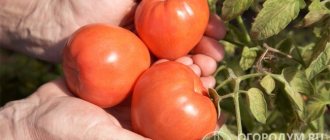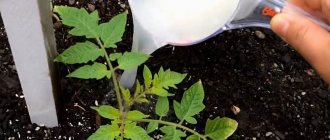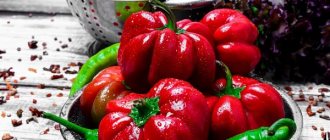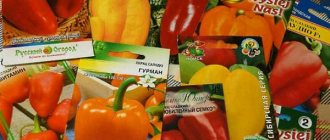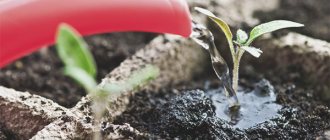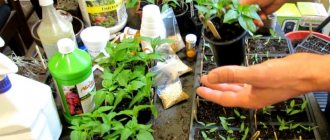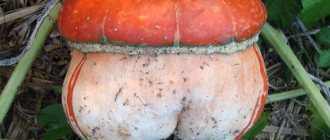Let's start - as a rainbow begins - with red peppers. This is probably the largest group among all their varietal diversity. And from this armada of red peppers it is not so easy to single out just one favorite, but our choice is obvious. It is not for nothing that he bears the highest military rank - Pepper 'Marshal' F1 .
Sweet pepper 'Marshal' F1
The huge fruits, whose weight often exceeds 400 g, and whose walls are about 1 cm thick, will not leave lovers of this crop indifferent. You just can’t take your eyes off the bush, which produces up to 10 fruits at a time. The hybrid is suitable for growing in open ground and film greenhouses. Productivity 8.0-8.5 kg/sq.m.
Who is faster and who takes longer?
Just a dozen years ago, growing sweet peppers in the middle zone could not be called successful and widespread. Thanks to selection, and the warming of the climate, which scientists scare us with (every cloud has a silver lining), peppers grow in almost all gardens. The main guarantee of the harvest is that the timing of the ripening of vegetables corresponds to the conditions of your climate. Therefore, for the northern regions it is better to select early varieties for which short summer heat will suffice, and residents of the southern regions can successfully grow varieties with a long ripening period. Growing in seedlings further increases the chances of getting the maximum yield of this healthy and tasty heat-loving crop.
- The most popular early varieties of sweet peppers: DimentioF1 (red fruits of various shades), white pepper Snowwhite F1 and Snow White (milk and cream-colored peppers). Super early pepper Yellow Bell (from the day the seedlings are planted to ripening 65-70 days). The California Miracle yellow pepper, familiar to many gardeners (very productive, early ripening with large fruits) and the large-fruited variety Zdorovye. Early peppers will be an excellent option for beginning gardeners, as they are the most productive. And sowing crops for seedlings in February - March allows you to do without greenhouses even in the northern regions of agriculture. The approximate period of ripening of the fruits of early peppers, from the moment of emergence, is 110 - 125 days.
- Mid-season varieties: unpretentious Bogatyr, popular varieties Crystal and Novocherkassky, Gogoshar pepper with colorful fruits. The ripening period from germination to technical ripeness is 121 -135 days. The advantage of a medium-ripening harvest is that it falls during the hottest summer season, when housewives are preparing and preserving, which means there will be no shortage of vegetables.
- Late ripening peppers: the familiar hybrid ParisF1 and the new selection NochkaF1 (beautiful dense fruits of rich dark purple color). Late-ripening peppers give the best harvest when planted indoors, because they need from 135 to 150 days to ripen. But at a time when garden beds are already empty and fresh vegetables are on the decline, the harvest of late peppers is coming into full force.
Tomato variety White filling on video
If you grew White Naliv tomatoes, please write whether you liked them or not. What was the yield and taste of the fruits like under your climatic conditions? How do you rate the disease resistance of this variety? Briefly describe the advantages and disadvantages of this tomato in your opinion, and evaluate its taste. If possible, attach to the comment a photo of the entire bush as a whole or individual fruits that you grew. Thank you!
Your reviews of the White filling tomato and additions to the description will help many gardeners evaluate this variety and decide whether it is worth planting or not.
Characteristics and description of tomatoes of the White Naliv variety
Cucumbers and tomatoes are the most beloved vegetables among people, without which not a single table can do. Therefore, everyone who has their own plot of land tries to cultivate the best varieties of these vegetables on it. One of the best varieties for growing in a personal plot is the White Naliv tomato. It germinates early and gives good yields, is easy to care for, but the variety also has several features that you need to know.
Characteristics and description of tomatoes of the White Naliv variety
Description of the tomato variety White Naliv
The Bely Naliv tomato variety was first cultivated by Russian agronomists in the mid-70s by crossing several varieties.
White Bulk is distinguished by its versatility and ease of care. Its versatility lies in the ability of the plant to take root and bear fruit in different climatic zones of the country. The White Naliv tomato withstands severe frosts, so even in the north, seedlings in the greenhouse sprout and grow actively.
The characteristics of the variety have a number of features:
- Belyi Naliv is a determinate variety, so the bushes grow to a small height. When cultivated in greenhouse conditions, the tomato grows up to seventy centimeters in height, and when planted in open ground up to fifty centimeters. This feature allows you to grow Belyi Naliv tomatoes without the use of support structures.
- The first ovaries are formed from the sixth full leaf, and the rest are located every two. Each inflorescence contains from two to four flowers. After the formation of several full-fledged brushes on the bush, the plant stops growing. For many gardeners, this is a huge plus; an adult bush does not need to be topped.
- Stepping is not necessary, but according to the experience of most gardeners, diverting the bulk of the growth to the side branches of the shrub allows you to extend the fruiting period.
Yield characteristics
Each bush (as described at the time of cultivation) is capable of producing from three to five kilograms of tomatoes. This is not the most striking indicator among universal varieties, but at that time, such a yield was a record.
Main characteristics of productivity:
- Early fruit ripening. From the moment of planting seedlings in open ground to harvesting, no more than one hundred days pass. In greenhouse conditions, fruits ripen faster. The harvest is ready for harvest on the eightieth day.
- Tomato productivity is average. Often the yield of this hybrid is compared with the yield of later varieties. You can harvest more than eight kilograms of tomatoes per square meter.
- All fruits ripen at the same time. This allows the gardener to immediately harvest a large harvest and begin processing the fruits.
Fruit characteristics
The fruits of the plant have a thick skin
The description of the fruit has a number of features that will please any gardener:
- The fruits vary in weight, depending on where the seedlings are planted. In greenhouse conditions, almost every tomato reaches a weight of 130 grams. In open ground, the weight of tomatoes rarely exceeds 80 grams.
- The shape of tomatoes is round, slightly flattened, the surface is smooth.
- White Pouring received its name due to the color of the fruit during ripening. When the fruits are not yet ripe, they have a light white tint, which turns into bright red when ripe.
- The pulp of the fruits of this plant is worthy of special attention: it is juicy and fleshy. The pulp has a slight pleasant sourness, which persists even after preservation.
- The skin of tomatoes is dense and does not crack when left on the bush for a long time after ripening. The only thing that adversely affects the condition of the fruit is sudden temperature changes day and night. And only then can the peel burst.
- The fruits and the plant itself are resistant to damage by various fungal diseases and parasites.
- Due to their density and the possibility of long-term storage, the fruits tolerate transportation and capping well.
Choosing a variety according to the place of cultivation
Pepper varieties for open ground
First you need to find out where you will grow peppers: will it be open ground and light shelters or polycarbonate stationary greenhouses.
In the photo: Zorka and F1 Medalist
In the first option, in the conditions of the Middle Zone, preference should be given to the earliest varieties and hybrids with a ripening period of 90-100 days.
As a rule, these are peppers with a cone-shaped fruit, such as, for example, the Zorka variety with a ripening period of 90-95 days, fruits weighing 100-130 g, wall thickness up to 0.8 cm with a white-yellow color of fruits at technical ripeness, passing in red in biological. Read on for more varieties of cone-shaped peppers.
Of course, you can plant cube-shaped and prismatic peppers, but since they have a longer growing season, their yield and, most importantly, the quality of the fruit may not live up to expectations if the weather conditions of the Middle Zone fail.
In the southern regions, for open ground conditions, you can choose any type of pepper.
According to the duration of the growing season (from emergence to technical ripeness), varieties are distinguished: very early - less than 100 days, early - 101-120, mid-early - 121-135, late - 136-150, very late - more than 150 days. Many traits change depending on growing conditions. Fruiting may be delayed by 20 days or more. Lack of moisture in the soil leads to a decrease in the height of the bush, the size of the leaf and fruit, and a decrease in yield. With a lack of light, plants stretch, the size of leaves increases, and the growing season lengthens.
Characteristics of the variety
The height of the White filling apple tree reaches 4 - 5 meters, which is considered an average size.
The crown of the tree is broadly pyramidal at a young age and becomes rounder as it matures.
The color of the bark is light gray. The fruits are concentrated mainly on the ringlets.
The apple tree is covered with medium-sized leaves, usually elliptical, sometimes ovoid. The leaves are more pubescent on the underside than on the top, which gives a matte shade to their gray-green color. Pale-colored leaf petioles are usually elongated.
A characteristic feature of the White Filling variety has always been large flowers with white or slightly pinkish petals. The level of the anthers is slightly lower or level with the pistil.
Description and characteristics of the variety
White pepper belongs to the early species. Used for cultivation in greenhouses and open beds. It is cold resistant. Sharp temperature drops do not affect the productivity of the variety.
Pepper grows in semi-spreading bushes of medium length, the shoots stretch up to 50–60 cm. The plants are distinguished by their strong stems and developed root system.
White bell pepper bears marketable, beautiful fruits:
- average weight - 60–70 g;
- shape - elongated, cone-shaped;
- color - initially remains creamy for a long time, with the onset of biological ripeness the peppers turn red;
- the skin is strong, varnished, smooth;
- the pericarp reaches 5–6 mm in thickness.
The peppers have a pleasant sweetish taste and neat, even sizes. They are convenient to use for canning and pickling. The fruits add aromatic notes to fresh appetizers and salads. The variety is rarely affected by TMV and Verticillium wilt.
Tips for growing seedlings
Basic information about the varieties Lumina, White Bell, Century, Star of the East and others can be found among the yellow and red varieties. Lack of information leads to the fact that the authors of some articles confuse white varieties of bell pepper with white pepper, which is used as a spice and is obtained from black peppercorns.
White pepper is not a variety, but different varieties that at a certain stage become white. Experienced gardeners advise growing seedlings in separate pots to avoid picking. It should be fed before planting in the soil and at the level of 2-3 leaves. Hybrid seeds do not need to be processed or soaked; if collected independently, it is better to treat them with potassium permanganate to avoid infection.
White pepper filling description
It is recommended to feed “White Naliv” sweet pepper no more than 4 times during the entire growing period. The first feeding should be carried out at the seedling stage, after the emergence of seedlings, the second - after picking the seedlings, the third - at the beginning of flowering and the fourth - at the beginning of fruiting. Among the “folk” fertilizers, a solution of cow or bird droppings is used. But it is best to use factory fertilizers: Agricola, Zdraven, Gumat, Orton, etc. These factory feeds and fertilizers are sterile and environmentally friendly; they are perfectly absorbed into plants in the right doses and do not cause nitrate in the fruit.
Varietal characteristics of sweet pepper “White filling”.
An early-ripening, high-yielding variety of sweet pepper (from germination to technical ripeness of the fruit 90 - 100 days). “White filling” is famous for its amazingly tasty fruits, their shape is elongated and cylindrical. The average fruit length is 8 cm, width is 4 cm, wall thickness is up to 6 mm, weight is 50 – 90 g. The color at technical ripeness is cream, at biol. ripeness – dark red. The fruits can be consumed fresh and can also be culinary processed into a variety of delicious dishes. The plants are medium-sized - up to 60 cm in height, 6-8 fruits are set at a time, the crown is semi-spreading - the variety requires garter to a trellis. “White filling” is resistant to fusarium and verticillium, has an extended fruiting period, has high marketability and taste, and the transportability of the fruit is good. Productivity 4.5 – 5.5 kg per plant.
Growing thick-walled sweet pepper “White filling”.
Despite the fact that “White Bulk” pepper is an early-ripening variety, for maximum yield it must be grown through seedlings. To successfully grow powerful and viable seedlings, the ambient temperature must be kept within 22 - 26 degrees. Sowing of pre-soaked seeds of the “White Pouring” pepper is carried out in early March; it is recommended to grow in single-cell seedling containers (1 seed is planted in 1 cell) or in peat tablets (1 seed is planted in 1 tablet) - sweet pepper seedlings grown in such containers invariably have strong root system, buds and powerful stem. Seedlings grown in a box require picking in the cotyledon phase. The best soil for seedlings is a soil mixture consisting of 1 part clay and 2 parts fertile soil. This substrate retains moisture and heat well; to prevent the development of putrefactive diseases in immature seedlings, it is recommended to mulch the soil with dry sand. After planting the seeds and watering the substrate, the containers are covered with film or glass, which are removed after germination. “White filling” pepper seedlings are planted at the age of 60-70 days, per 1 sq.m. 3-4 plants are placed.
Care
for sweet peppers, “White filling” consists of watering, weeding, loosening and fertilizing. The variety does not require a garter; it can be formed into 2 stems.
White pepper is not a separate variety, but a group of varietal hybrids and independent types of pepper. The description of the variety mentions a white color that is not typical for pepper in a state of technical ripeness. In its unripe form, it contains a large amount of vitamins and is suitable for consumption. Such varieties have a set of certain useful components. Only the Dutch hybrid White Bell can be considered truly white, turning ivory when ripe.
The white pepper in sweet bell peppers is a variety that is in particular demand. Even in its unripe form, it is suitable for consumption and contains a large amount of vitamins, minerals and nutrients. Advice on growing seedlings always mentions this feature.
Tips for growing seedlings
Basic information about the varieties Lumina, White Bell, Century, Star of the East and others can be found among the yellow and red varieties. Lack of information leads to the fact that the authors of some articles confuse white varieties of bell pepper with white pepper, which is used as a spice and is obtained from black peppercorns.
White pepper is not a variety, but different varieties that at a certain stage become white. Experienced gardeners advise growing seedlings in separate pots to avoid picking. It should be fed before planting in the soil and at the level of 2-3 leaves. Hybrid seeds do not need to be processed or soaked; if collected independently, it is better to treat them with potassium permanganate to avoid infection.
White pepper: Overview of varieties
Calota F1
A favorite variety of those who rotate crops in the garden and grow abundant and varied crops of vegetables in a small area, taking into account proper agricultural techniques. Kalota is one of the earliest varieties, and ripens in just 60 days from the moment the seedlings are planted. This is a variety of white pepper that people incompetent in gardening underestimate because, in their opinion, the color is not dominant enough. Hybrid seeds from the originator do not require additional processing, because during packaging they are treated with a fungicide for disease resistance.
Skilled gardeners use this quality for the correct rotation of areas and plant daikon radish after the bushes have been removed, which still have time to ripen before autumn. After the radish, next year you can plant pepper again in the same place.
Snowwhite
An early-ripening hybrid with a whitish-yellowish fruit color, bred by Dutch breeders according to the Hungarian waxy type. According to gardeners, it is characterized by high productivity and produces abundant fruits, although not very large. They weigh 130-160 g, with a wall thickness of 4-5 mm, oblong, 12 to 15 cm in length. Snowwhite becomes white for a short time, in a state of technical ripeness, and at this moment it contains the largest set of useful substances. Therefore, in Europe it is filmed and sold during this period.
It has an excellent ability to preserve its presentation and transportation for a long time. The variety has good shelf life when stored under optimal conditions. When fully ripe, the fruits acquire a rich orange color, and in certain regions it is harvested once this color has been reached.
Star of the East white
Any variety of Eastern Star, regardless of the shade it received from its breeders (there are red, yellow, golden, purple, tangerine, giant and chocolate), is distinguished by excellent taste, juiciness and suitability for any culinary needs.
White Star of the East, like all the others, is a hybrid that was included in the State Register of the Russian Federation in 2007 and is recommended for cultivation in different types of greenhouses and in open ground.
Hybrids have a number of advantages:
- resistant to verticillium wilt and tobacco mosaic;
- early ripening;
- high-yielding and indeterminate.
White Star of the East gives 8-10 kg with proper agricultural technology. But it reaches this color only in a state of technical ripeness. By the way, both White in red and White in yellow are considered white varieties, which change their color to red and yellow when fully ripe.
Belozerka (Lumina)
A standard medium-sized plant, which is in the desired state (white color or technical ripeness) for 110–115 days, and when fully ripe it becomes rich red. This happens around day 135. Fruits in a state of technical ripeness are valued higher. The crop is almost always harvested at this stage.
A super early variety, bred by Moldovan breeders, with a characteristic golden-white color, which many do not know by name, but is one of the very first to see on market shelves. Bush of medium height, fruits around 100 g. Stable, reliable, medium-yielding and very unpretentious variety that rarely lets its owner down. Thin-walled fruits do not have the most original, but rather a standard taste.
Ivanhoe
A relatively young variety, bred in Africa at the end of the twentieth century, but already included in the State Register of the Russian Federation as recommended for cultivation in greenhouse conditions. In open ground it can only grow in the south. An early variety with fleshy walls and a wonderful aroma, which is harvested in a characteristic creamy shade 100 days after planting the seedlings.
The peppers are about 100-130 g, cone-shaped, and become bright red when fully ripe. The variety is used for industrial cultivation. It yields 80 centners per hectare.
White bell
Dutch hybrid, white in technical filling, yellowish-cream when fully ripe. Large-fruited, medium-yielding. It is easy to care for and does not have a very characteristic taste and smell, like most Dutch hybrids. Seed material must be purchased annually; the seeds have already been treated against pests.
Century
A hybrid with cone-shaped fruits, an average weight of 250-170 g, a yellowish tint when early filling, and orange-red when it reaches final ripening. A Hungarian variety capable of bearing fruit for a long time, throughout the entire growing season, with a stable yield and high quality fruit. It can be grown in open ground or under film; it is not afraid of either heat or poor watering.
Rules for growing white pepper
The rules for growing white pepper are no different from the agricultural practices of other nightshade fruits with fruits in the form of pods, known under the general collective name of sweet bell pepper. If we take into account that some varieties of white pepper, by inertia, are included in plant catalogs based on the color of the fruit in a state of full ripeness, we can understand that no special requirements are put forward for the breeding of varieties.
All varieties of white pepper have long been known to experienced gardeners and have gained an excellent reputation. Star of the East has long been successfully grown - an excellent productive hybrid from domestic breeders, which in some respects is not inferior to or even surpasses the well-known varieties from Dutch breeders. White pepper, collected in a state of technical ripeness, has many beneficial properties that the buyer of varieties with an uncharacteristic color wants to receive.
White fruits collected from pepper bushes have, according to doctors, additional medicinal properties:
- these are strong immunostimulants that can enhance a person’s natural immunity at a time when it is even simply weakened by a seasonal lack of vitamins;
- they optimize the functioning of the gastrointestinal tract and accelerate natural metabolism at the cellular level;
- have the property of purifying and thinning the blood, preventing the formation of clots and blood clots;
- perform the work of natural anticoagulants and antioxidants due to the beneficial substances they contain;
- accelerate metabolic processes, help remove harmful cholesterol and natural fat burning, promote the treatment of obesity and other endocrine pathologies.
Reviews
Ivan Danilovich, 52 years old, Rivne:
“I have been growing the Belozerka pepper variety for a long time. It is quite resistant and is not afraid of viral infections. By following the planting rules, I always get a good harvest. I leave a distance between rows of 60 cm, and between plants – 35-40 cm. The whole family is happy, as the pepper tastes amazing and is very juicy.”
Larisa Sergeevna, 67 years old. Kishinev:
“Every year I grow an early Century variety in the greenhouse. I usually plant 1 sq. meter 3-4 plants. The variety is very resistant to various stressful situations. It is easy to transport, which is very important to me. My husband and I sell it at the market, where it is in great demand.”
Our company sends seeds, seedlings, any planting material, gardening products throughout Russia: Moscow, St. Petersburg, Tver, Yekaterinburg, Nizhny Novgorod, Novosibirsk, Krasnoyarsk, Irkutsk, Khabarovsk, Rostov-on-Don, Kazan, Samara, Omsk , Chelyabinsk, Ufa, Perm, Voronezh, Krasnodar, Volgograd, we are available anywhere in our great country.
